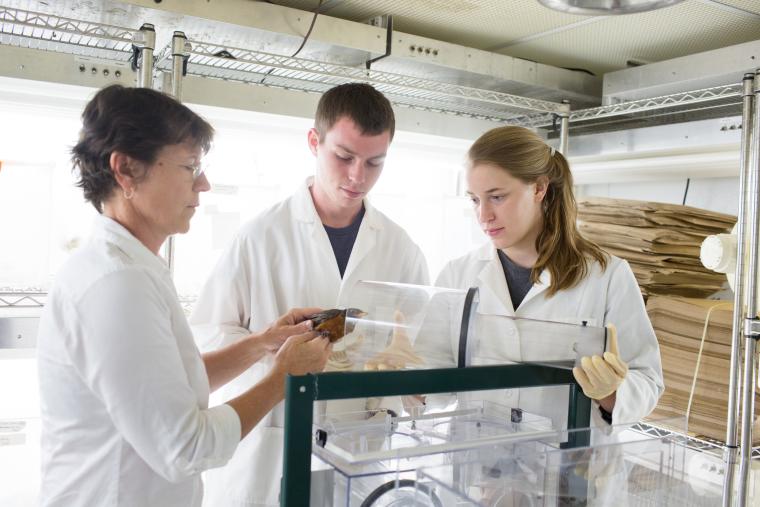Closing the Loop on West Nile Virus
October 8, 2015
Amanda Nagy

People tend to think of mosquitoes as predators.
Both males and females drink plant juices for their basic carbohydrates, but only the female takes a blood meal to develop a batch of eggs. The female seeks a pool of water to deposit her eggs, which then hatch and develop into aquatic larvae. The larvae develop into aquatic pupae from which the adults emerge, thereby continuing the life cycle.
Professor of Biology Mary Garvin is an expert in insect-borne disease cycles. As a community ecologist, she’s interested in how organisms interact with each other and the mechanisms that mediate those interactions.
Her current research focuses on West Nile Virus and the interaction between birds and mosquitoes. On a basic science level, she’s interested in why a particular species of mosquito forages on a particular species of bird; on an evolutionary level, she seeks answers to understand why those interactions have evolved.
Year after year, West Nile Virus circulates among particular species of birds, and in certain years, the disease spills out of what’s called a reservoir population into the human population, Garvin explains. There are 61 species of mosquitoes present in Ohio. Only a few of those 61 species of mosquitoes are involved in maintaining the virus cycle from one bird to the next.
“At a community ecology level, that’s really interesting,” Garvin says. “What drives that interaction, both chemically and evolutionarily. Have birds evolved chemicals that repel? Have mosquitoes evolved a mechanism to focus on some sort of a metabolic byproduct that the bird can’t help but produce? It’s really interesting at a basic science level about how species interact.”
That basic science has public health applications. Garvin says researchers already know which birds are involved in the West Nile cycle and the times of year when transmission is most likely to occur. The next piece of the puzzle is to better understand why particular species of birds and infected mosquitoes are likely to interact. “We can better understand that interaction by finding out what chemicals the mosquitoes are attracted to.”
Garvin’s hypothesis that volatile chemicals in the secretions of birds’ feathers may explain these interactions is now being tested in her lab. She hopes it will close the loop on nearly 10 years of collaborative research with Associate Professor of Chemistry Rebecca Whelan.
Birds of a Feather
Garvin was a PhD student at the University of Florida in the early ’90s when she got the idea that secretions in birds’ feathers could be giving off volatiles that either attract or repel mosquitoes. She was working on two species of jays, Florida scrub jays and blue jays. “We saw different prevalences of mosquito-borne disease in these two species that were living in the same place. This means there could be something going on ecologically. Maybe the flies were interacting with them differently, or there could be innate differences in their immune systems.
“It got me wondering if these secretions the birds spread on their feathers when they preen were giving off these volatiles, and maybe mosquitoes were either queuing in on these chemicals for one species or being repelled for another species. I needed an analytical chemist.”
Fast forward a little more than a decade later, when Rebecca Whelan joined the chemistry faculty. The two were brought together by Tara Levin ’07, who was taking Garvin’s community ecology course and Whelan’s analytical chemistry course concurrently. In the lab for Garvin’s lecture, Levin had the idea of testing chemical compounds as a means to answer the question of why disease-carrying insects bite some bird species and not others.
The first paper resulting from their collaboration, coauthored by Levin, was published in the Journal of Comparative Biochemistry and Physiology. Their second paper made the cover of the Journal of Chemical Ecology in 2011.
Whelan’s lab analyzes the chemical compounds in the birds’ preening secretions using a major workhorse technique, gas chromatography-mass spectrometry. Their analysis has determined that the secretions have abundant compounds with completely different chemical profiles.
Now, using a three-bird comparison and new instrumentation, Garvin and Whelan are trying to answer the question: Do the differences among the species and their secretions have any causal effect?
The collaboration between Garvin and Whelan is an example of how scientists continue to develop collaborative relationships. The same has held true for students in both labs. “Our students have been involved in every aspect of the projects, sharing in the biology field work and the chemical analysis in the lab,” Whelan says. “It’s not just a hand-off at the door.”
Working Inside the Box
Down the hall from Garvin’s office, behind a closed door with a sign reading “See Mary Garvin before entering,” is a brightly lit microclimate set to 74 degrees and 80 percent humidity, filled with glass boxes containing thousands of male and female mosquitoes in varying stages of the life cycle. This is Garvin’s mosquito colony.
Maintaining the colony is a round-the-clock affair for Garvin and her student researchers. There’s the daily feeding of 10 percent sugar water, which mimics what would happen in nature if the mosquitoes were drinking plant juices. Once a week, the females are given a blood meal through a self-administered system to get them to lay eggs. Before the blood meal, however, they must remove the sugar water for a full 24 hours. A week later, the mosquitoes lay their eggs on the surface of water in an artful little arrangement called an egg raft. Each phase of the life cycle is carefully recorded—they even know the exact ages of the adult mosquitoes.
“My students make sure the water is clean and the feeding is done correctly for each stage of the life cycle and that everything is labeled properly. They juggle a lot of different balls here,” Garvin says, explaining the importance of teaching responsibility and problem-solving. “We all make mistakes sometimes. To see the ramifications, that’s how you really understand an organism’s biology, how it responds to your mistakes.”
All those considerations will come into play when Garvin’s lab runs a set of experiments in a newly deployed instrument called an olfactometer, a highly controlled environment that allows them to observe mosquito preferences for one stimulus over another. It’s a glass box with several ports hooked up to a computer, and it works by moving a steady stream of air through the box, putting stimuli in ports on one end and mosquitoes on the other end, and testing to see if they choose one over another. The stimuli in this case are birds (captured and released by Garvin and her students) and their secretions.
For this project, Garvin and Whelan are comparing three birds: American robins, house sparrows, and European starlings. Garvin says robins seem to be the most important in the West Nile Virus cycle.
This fall Garvin and her students are continuing the behavioral assays they began during the summer. These data will be used as the final piece of a manuscript that Garvin, Whelan, and their former students have been working toward for the past several years.
For an undergraduate, coauthorship is a meaningful endpoint that can only happen in a liberal arts setting. “We don’t think of our students as technicians,” says Whelan. “They are immersed in the literature and engaged in the scholarly conversation that’s happening in the world beyond Oberlin. They participate in that scholarly conversation by being coauthors on papers and presenting posters at conferences.
“Seeing a project all the way to the point where you are situating it in its intellectual context, communicating about your findings and the hypotheses you are testing—I think that’s really satisfying for students. That’s a big part of why faculty here do what they do. Yes, the generation of new knowledge is important, and that’s why we do the research, but the training of the students is just as important.”
Tags:
You may also like…
Oberlin Summer Research Institute Partners with Career Exploration and Development, Expands Capacity
January 17, 2025
For almost 20 years, Oberlin Summer Research Institute, or OSRI, has been fostering community and the development of Oberlin students. Now, beginning in summer 2025, the program will offer exciting new opportunities.
Ava Harvey ’26 Earns Leadership Alliance Summer Research Fellowship
August 8, 2024
Ava Harvey ’26 received a Summer Research Early Identification Program (SR-EIP) Fellowship from the Leadership Alliance.
Freya Kailing ’25 Named 2024 Goldwater Scholar
August 7, 2024
Freya Kailing ’25, a biology major from Kalamazoo, Michigan, received a 2024 Goldwater Scholarship, a prestigious award for college students planning research careers.


